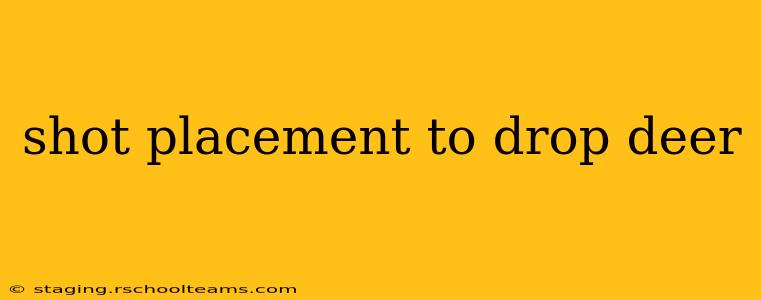Hunting deer ethically and effectively requires precision and understanding of vital anatomy. A well-placed shot ensures a quick, clean kill, minimizing suffering for the animal and maximizing your success as a hunter. This guide delves into the crucial aspects of shot placement for dropping deer, focusing on safety, accuracy, and responsible hunting practices.
Understanding Deer Anatomy: Key Target Areas
Before discussing specific shot placements, it's crucial to understand a deer's vital organs. The most effective shots target areas where vital organs are concentrated, leading to rapid incapacitation and death. These primary areas include:
1. The Heart and Lungs: The Primary Targets
The heart and lungs are situated within the chest cavity, and a well-placed shot to this area is the most reliable method for a quick kill. Aim for the vital zone, located just behind the deer's shoulder, slightly below the spine. This area offers the largest target and the highest probability of hitting both the heart and lungs.
2. The Broadside Shot: Maximizing Accuracy
The broadside shot, where the deer is facing perpendicular to you, presents the best opportunity for an accurate shot to the vital zone. Visualize a line drawn from the deer's shoulder to its opposite hip – aim slightly behind the front leg, aiming for the area where the heart and lungs are located.
3. The Quartering-Away Shot: A Challenging Angle
A quartering-away shot (the deer is angled away from you) is more challenging, requiring careful consideration of bullet trajectory. To avoid harming the animal unnecessarily, aim for the far-side shoulder, aiming behind the front leg to reach the heart and lungs. Avoid shots that might penetrate the shoulder bone or pass through the animal without causing fatal damage.
4. The Head Shot: High-Risk, High-Reward
While a headshot can be effective, it’s generally considered a risky shot, particularly for less experienced hunters. A slight miss can result in a wounded animal. Only attempt a headshot if you’re confident in your abilities and the shot presents itself at a very close range and with a clear, unobstructed view.
Shot Placement Considerations: Beyond the Basics
Several other factors contribute to successful and ethical shot placement:
1. Bullet Selection: Matching Caliber to Game
Choosing the right ammunition is vital. Use a caliber appropriate for deer hunting and consider bullet construction for optimal penetration and expansion within the target area. Consult your hunting regulations and seek advice from experienced hunters regarding appropriate bullet choices.
2. Range: Know Your Limits
Accuracy decreases significantly with distance. Don’t attempt shots beyond your effective range. Knowing your firearm's limitations and practicing at various distances is crucial for responsible hunting.
3. Angle and Body Position: Assessing the Shot
Proper positioning is essential for a clean shot. Ensure you have a stable shooting platform and are comfortable before taking the shot. Consider the angle of the deer and avoid shots that could risk wounding the animal without a fatal outcome.
4. Weather Conditions: Impact on Accuracy
Wind, rain, and temperature can affect shot accuracy. Adjust your aim accordingly, and be mindful of how weather conditions might impact your shot’s effectiveness.
Post-Shot Procedures: Ethical Considerations
After taking a shot, it's crucial to follow ethical hunting practices:
- Tracking: If the deer doesn't immediately fall, carefully track the animal.
- Recovery: Find the animal quickly and efficiently to minimize suffering.
- Dispatch: If the animal is still alive but severely wounded, use a humane method of dispatch to end its suffering.
Conclusion: Precision and Responsibility
Effective shot placement is not merely about dropping a deer; it's about ethical hunting and respecting the animal. By understanding deer anatomy, practicing regularly, and following responsible hunting practices, you can significantly increase your success rate while ensuring a quick, clean, and humane kill. Remember, practice and education are paramount. Always follow your local hunting regulations and seek guidance from experienced hunters if needed.
